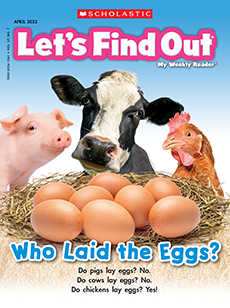A guide for using our resources
Children will sequence the steps of a groundhog’s life cycle.
Vocabulary: burrow, herbivore
Science Focus: animal life cycles
Simple, spectacular ideas to boost your lessons.
Paired Text: Groundhog’s Day Off by Robb Pearlman
Paired Text: Groundhog’s Day Off by Robb Pearlman
- Groundhog is tired of being undervalued. All anyone asks him about is the weather! This hilarious book answers the question, “What would happen if the groundhog quit?”
Knowledge-Building Dice Game: Groundhogs
Knowledge-Building Dice Game: Groundhogs
- Play this game in small groups. Print out the skill sheet and give children a number cube. Let children take turns rolling the cube and following the directions.
- This is a great interactive way to build knowledge!
Scavenger Hunt: Pages 2-3
Scavenger Hunt: Pages 2-3
- Use pages 2-3 of the issue to do this scavenger hunt as a group.
- Find the heading. Underline it.
- Find the picture where the kit is taking a ride. Put a ✔ on it.
- In the blue box, find the word that means “an animal that eats plants.” Circle it.
- Look at the bottom bar. Find two plants that both groundhogs and people eat.
Hands-on Activity: Hand Shadows
Hands-on Activity: Hand Shadows
Skill: investigating
Materials: Hand Shadows skill sheet, pencil, flashlight
- Tell children the story of Groundhog Day. It says that groundhogs come out of their burrows on February 2 and look around. If they see their shadows, there will be six more weeks of winter. If they don’t, there will be an early spring. Then tell kids that they will investigate how to make their own animal-shaped shadows.
- Turn off the lights, or choose a dark spot in the room. Turn on the flashlight and shine a spot on a wall. Put your hand in front of the light and wiggle it around. Tell kids a rabbit shape is about to appear on the wall. Curl in your fingers so that only your pointer and middle finger create the rabbit hand shadow.
- Then provide small groups with flashlights and Hand Shadows skill sheets. Have kids work together to make all the shadows on the sheet. They can take turns using the flashlight, making the shape, and crossing off each shadow puppet on their sheets.
- Then ask students to try to make their own shadow puppets. They can draw and label their idea on their sheet. Last, have volunteers show the class their shadow puppet creation!
